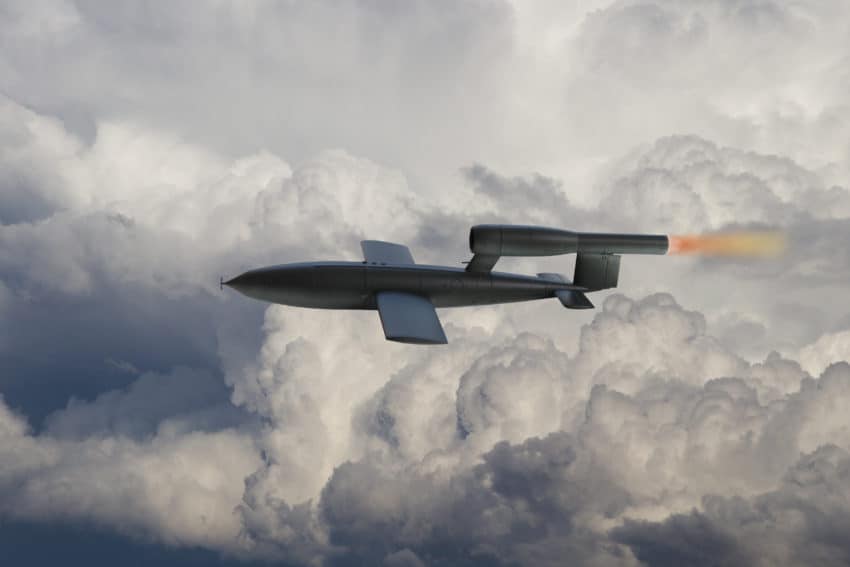
V1 Flying Bomb of World War II used by the Germans to attack London, England. (Artist Impression Digital Painting). Keith William Tarrier 123rf.com Click to enlarge.
By Phil Kohn. Dedicated to the memory of his father, GM3 Walter Kohn, U.S. Navy Armed Guard, USNR, and all men and women who have answered the country’s call in time of need. Phil can be contacted at ww2remembered@yahoo.com.
Units of the U.S. Army’s 27th Infantry Division on June 16, 1944, land on Saipan and advance on Aslito Airfield, in the south. The Americans repulse several Japanese counterattacks that night. In Europe, 95 German V-1 “flying bombs” cross the English coast from launch sites in France before 6 a.m., with a total of 244 reaching England that day. The German press calls it the “beginning of the day of vengeance.” In Italy, the British Eighth Army continues its advance, while forces of the U.S. Fifth Army capture Grosseto. Great Britain’s King George VI visits with the troops in Normandy.
On June 17, Hitler meets with Field Marshals von Rundstedt and Rommel in occupied France. Both officers seek permission to withdraw to a more-defensible position inland, but Hitler refuses to allow a retreat, arguing that the V-1 bombing of Britain will force it out of the war. Cutting its ties with Denmark, the government of Iceland establishes the Icelandic Republic.
On Saipan, the U.S. 4th Marine Division reaches the east side of the island on June 18. The Americans then begin pushing northward: the 2nd Marine Division in the west, the 4th Marine Division in the east; the Army’s 27th Infantry Division, having captured Aslito Airfield, moves up the middle. The island of Elba, in the Mediterranean, is liberated by Free French 9th Colonial (Senegalese) troops. In Finland, forces of the Soviet Leningrad Front break through Finnish defensive positions and advance toward Viipuri. In Rome, Ivanoe Bonomi replaces Pietro Badoglio as prime minister of Italy. In China, the Japanese capture Changsha, in Hunan Province.
The Battle of the Philippine Sea begins on June 19. Concerned that American control of the Mariana Islands would put bombers in range of the Japanese home islands, the Imperial Japanese Navy launches a major counterattack. Committing all of its major ships and hundreds of carrier- and land-based aircraft, IJN plans to destroy the American invasion fleet in the vicinity of Saipan, crippling the U.S. Navy. (The Japanese force: 9 carriers, 5 battleships, 13 cruisers, 31 destroyers, 24 submarines, 6 oilers and 750 aircraft; the U.S. Fifth Fleet: 15 carriers, 7 battleships, 21 cruisers, 68 destroyers, 28 submarines and 900 aircraft.) On the first day, the Japanese lose two fleet aircraft carriers to torpedo attacks by U.S. submarines. In England, the Air Ministry releases the first official details on the German V-1s — range: 150 miles; speed: 300-350 mph; armament: a 2,000-lb bomb. British anti-aircraft gunners start calling the missiles “doodlebugs,” a common name for a variety of flying insects.
The British take Perugia, Italy, on June 20. In India, the Japanese continue their withdrawal from Imphal. In Occupied Poland, the Nazis begin mass exterminations at the Auschwitz concentration camp.
The Battle of the Philippine Sea concludes on June 21 — a resounding success for the Americans. The Japanese Imperial Navy’s carrier arm is annihilated, losing a total of 600 aircraft, three fleet aircraft carriers and two oilers against U.S. Navy losses of 100 aircraft. The air-to-air portion of the battle becomes known as “The Great Marianas Turkey Shoot” for the ease with which Japanese planes have been eliminated. The Red Army captures Viipuri, Finland.
On June 22, the Soviets begin “Operation Bagration,” a huge offensive intended to clear German forces from Belorussia (White Russia). The action begins with assaults by the Soviet 1st Baltic, and 3rd, 2nd and 1st Belorussian Fronts against Army Group Centre on a 450-mile front. Soviet forces amount to 124 divisions, 1,200,000 men, 5,200 tanks, 30,000 guns and 6,000 aircraft. Against this, the Germans can field just 63 divisions, including 900 tanks and 10,000 guns. The Luftwaffe launches a surprise night raid by 60 aircraft on the U.S. 8th Air Force’s shuttle base at Poltava, in Ukraine, destroying 44 B-17s and 500,000 gallons of fuel. In the U.S., President Roosevelt signs the Servicemen’s Readjustment Act of 1944, known as the “G.I. Bill,” which will provide funds for housing and education after the war for returning U.S. servicemen.
In India, the British 2nd Division and the 5th Indian Division on June 23, 1944, meet on the Kohima-Imphal road, which is now completely clear of Japanese, lifting the 88-day siege of Imphal. In Europe, the Allies drop 1,100 tons of bombs on Cherbourg, France. The communist-organized sabotage group, BOPA, part of the Danish Resistance, attacks the Riffelsyndikatet arms factory in Copenhagen.
The Soviets report major advances against Army Group Centre on June 24. Hitler orders all but one of the five German divisions of the LIII Korps that are encircled at Vitebsk, Belorussia, to fight their way out. In the Pacific, Japanese bases on Iwo Jima, in the Volcano Islands, and Chichijima, in the Bonin Islands, are attacked by American carrier-based planes.
On June 25, the Battle of Tali-Inhantala begins in Finland, between Finnish and Soviet forces. It is the largest battle to take place in the Nordic countries, with 150,000 Red Army troops facing off against some 50,000 Finns and 4,000 Germans. In France, three divisions of the U.S. First Army’s VII Corps penetrate the suburbs of Cherbourg.
In Poland, 25,000 German troops on June 26 surround the survivors of the Battle of Porytowe Wzgórze in the Solska Wilderness near Lublin. Some partisans manage to escape, but around 1,200 Polish fighters cannot break out and, after suffering some 400 killed, surrender. Some are executed on the spot, some are tortured for more information on resistance activities and the rest are shipped to concentration camps. Cherbourg, France, is liberated by American troops. In the Marianas, the fight for Saipan goes on. A small Japanese convoy heading for the island carrying reinforcements is turned back by the U.S. Navy. In response to recent incidents of sabotage, the Germans introduce a curfew in the Copenhagen area, making it illegal to be out in the streets between 8 p.m. and 5 a.m. In response, hundreds of thousands of Copenhagen citizens begin a massive general strike. German occupation authorities cut water, gas and electricity supplies to the city. In New York, the three city-based teams — the Yankees, the Dodgers and the Giants — play a unique, three-way baseball game at the Polo Grounds to raise money for War Bonds: Each team takes a successive turn at bat and alternates playing in the field. The final score: Dodgers, 5; Yankees, 1; Giants, 0. The game raises nearly $4.5 million.
The Red Army destroys the trapped German LIII Korps near Vitebsk, Belorussia, on June 27. Further gains are reported by the Soviets to the south of Vitebsk.
The Soviets take Mogilev, Belorussia, on June 28, and cross the Berezina River, a tributary of the Dnieper, surrounding most of the German Ninth Army. Having overseen the loss of 300,000 men of his 700,000-man force, Field Marshal Ernst Busch is sacked by Hitler as commander of Army Group Centre and replaced by Field Marshal Walter Model. In Vichy France, Minister of Propaganda Philippe Henriot is assassinated by members of the French Resistance. In the U.S., Thomas Dewey, Governor of New York, and John Bricker, Governor of Ohio, win the Republican nominations for President and Vice President, respectively, at the party’s convention. Dewey vows to “bring an end to one-man government in America.”
–––In Belorussia, some 70,000 troops of German Army Group Centre that are encircled near Bobruisk, near Vitebsk, surrender to the Red Army on June 29. The Soviets report that 16,000 Germans have been killed and 18,000 captured near Minsk. In the Ryukyu Islands, southwest of Japan, the Japanese troop transport Toyama Maru is torpedoed and sunk by the submarine USS Sturgeon. Some 600 Japanese personnel survive, but over 5,400 soldiers and crewmen die in the sinking, making the incident one of the worst maritime disasters in history.







